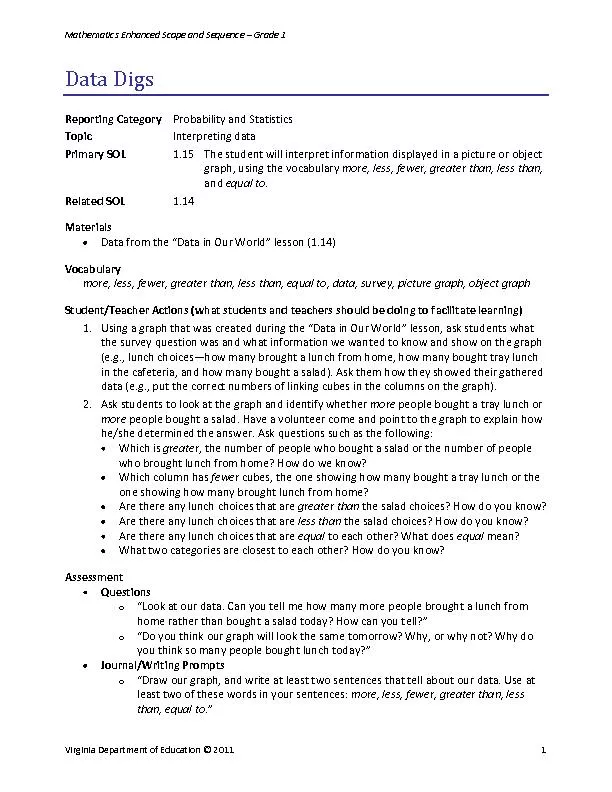/


x2013 Grade 1 Virginia Department of Education ID: 338429
Download Pdf The PPT/PDF document "Mathematics Enhanced Scope and Sequence" is the property of its rightful owner. Permission is granted to download and print the materials on this web site for personal, non-commercial use only, and to display it on your personal computer provided you do not modify the materials and that you retain all copyright notices contained in the materials. By downloading content from our website, you accept the terms of this agreement.
Mathematics Enhanced Scope and Sequence â Grade 1 Virginia Department of Education © 2011 1 Data Digs Reporting Category Probability and Statistics Topic Interpreting data Primary SOL 1.15 The student will interpret information displayed in a picture or object graph, using the vocabulary more, less, fewer, greater than, less than, and equal to . R elated SOL 1.14 Materials Data from the â Data in Our World â l esson (1.14) Vocabulary more, less, fewer, greater than, less than, equal to , data, survey , picture graph, object graph Student/Teacher Actions (what students and teachers should be doing to f acilitate learning) 1. Using a graph that w as created during the â Data in Our World â lesson , a sk students what the survey question was and what information we wanted to know and show on the graph ( e.g., lunch choices â h ow many brought a lunch from home , how ma ny boug ht tray lunch in the cafeteria , and how many bought a salad ). Ask them h ow they showed their gathered data ( e.g . , put the correct numbers of linking cube s in the column s on the graph). 2. Ask students to l ook at the graph and identify whether more peop le bought a tray lunch or more people bought a salad. Have a volunteer come and point to the graph to explain how he/she determined the answer. Ask questions such as the following: Which is greater , the number of people who bought a salad or the number of people who brought lunch from home ? How do we know? Which column has fewer c ubes , the one showing how many bought a tray lunch or the one showing how many brought lunch from home ? Are there any lunch choices that are greater than the salad choices ? How do you know? Are there any lunch choices that are less than the salad choices ? How do you know? Are there any lunch choices that are equal to each other? What does equal mean? What two categories are closest to each other? How do you know? Assessment Questio ns o â Look at our data . C an you tell me how many more people brought a lunch from home rather than bought a salad today? How can you tell? â o â Do you think our graph will look the same tomorrow? Why , or why not ? Why do you think so many people bought lunch tod ay? â Journal/Writing Prompts o â Draw our graph , and write at least two sentences that tell about our data. Use at least two of these words in your sentences: more, less, fewer, greater than, less than, equal to. â Mathematics Enhanced Scope and Sequence â Grade 1 Virginia Department of Education © 2011 2 o âExplain w hy people use graphs . Describe at l east one good thing about a graph. â o âThink about the different types of graphs you have seen. Draw a picture of some of the graphs you have seen in our classroom or in our school. â Other o Provide various pictures for students to sort and graph in the m ath c enter. Students may draw picture s in their journals of the graphs they made . o Provide manipulatives such as attribute blocks, pattern blocks, and cubes for students to use to make graph s of data . Have students discuss their graph s with you , and ask them que stions about the data represented in their graph s . Extensions and Connections (for all students) Have students g o on a graph hunt in the school to find other classrooms and/or hallways where graphs are displayed. Discuss the graphs with students. Visit a f ourth - or fifth - grade classroom to have those students share with your students how they use graphs to help them learn about science ( e.g., weather, plant growth) . Strategies for Differentiation Use grid paper to assist students in lining up vertical colum ns for graphs. Make an object graph with the student s themselves to show the number of girls and boys in the classroom. Have students identify which group has more or fewer members by pairing up with a partner. Provide students with three picture graphs , a nd have them determine which graph represents the collected data.